#Electrified Aircraft Propulsion
Link
#aircraft electrification#electrification of aircraft#electric propulsion aircraft#distributed electric propulsion#distributed propulsion#electric jet propulsion#hybrid electric propulsion#electric motor for aircraft propulsion#electrified aircraft propulsion#hybrid electric aircraft propulsion#turboelectric propulsion#hybrid propulsion aircraft#Electric Aircraft Propulsion System Market
0 notes
Text
Deputy forElectrified Aircraft Propulsion Integration Joe Connolly
“The goal is to get as many of the wrong ideas out of the way as early as possible. “So we’ll come up with some idea, especially on the research side, and sometimes it will seem really brilliant on the napkin or in a conversation with one other person. “[When I started working on electric […]
from NASA https://ift.tt/wiagPOp
0 notes
Text
Soaring into Aerospace: NASA Interns Take Flight at EAA AirVenture Oshkosh
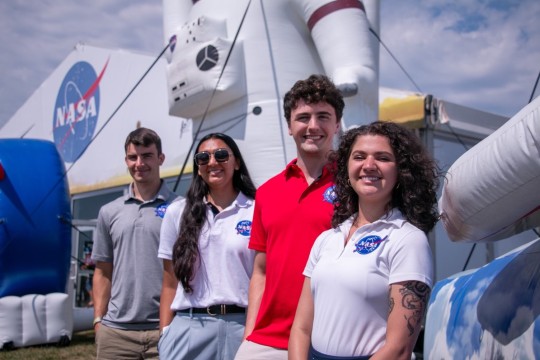
Sustainable Aviation Ambassadors Alex Kehler, Bianca Legeza-Narvaez, Evan Gotchel, and Janki Patel pose in front of the NASA Pavilion at EAA AirVenture Oshkosh.
It’s that time of year again–EAA AirVenture Oshkosh is underway!
Boasting more than 650,000 visitors annually, EAA AirVenture Oshkosh, or “Oshkosh” for short, is an airshow and fly-in held by the Experimental Aircraft Association (EAA). Each year, flight enthusiasts and professionals from around the world converge on Oshkosh, Wisconsin, to engage with industry-leading organizations and businesses and celebrate past, present, and future innovation in aviation.
This year, four NASA interns with the Electrified Powertrain Flight Demonstration (EPFD) project count themselves among those 650,000+ visitors, having the unique opportunity to get firsthand experience with all things aerospace at Oshkosh.
Alex Kehler, Bianca Legeza-Narvaez, Evan Gotchel, and Janki Patel are Sustainable Aviation Ambassadors supporting the EPFD project, which conducts tests of hybrid electric aircraft that use electric aircraft propulsion technologies to enable a new generation of electric-powered aircraft. The focus of Alex, Bianca, Evan, and Janki’s internships cover everything from strategic communications to engineering, and they typically do their work using a laptop. But at Oshkosh, they have a special, more hands-on task: data collection.
“At Oshkosh, I am doing some data collection to better estimate how we can be prepared in the future,” said Janki, an Aerospace Engineering major from the University of Michigan. “Coming to Oshkosh has been an amazing experience… I can walk around and see people passionate about the work they do.”
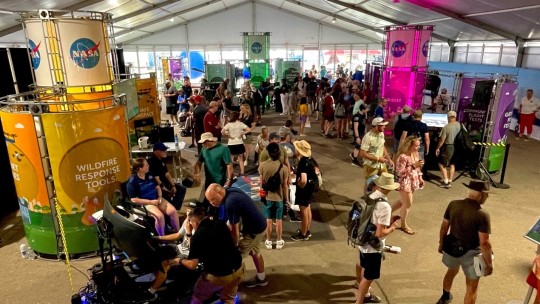
The NASA Pavilion at EAA AirVenture Oshkosh is full of interactive exhibits and activities for visitors to engage with. NASA Interns Alex, Bianca, Evan, and Janki are collecting data in the pavilion to help improve future exhibits at Oshkosh.
In addition to gathering data to help inform future NASA exhibits and activities at Oshkosh, the interns also have the opportunity to engage with visitors and share their passion for aviation with other aero enthusiasts. For Evan, who is receiving his Master's in Aerospace Engineering from the Georgia Institute of Technology, “being able to be here and talk with people who are both young and old who are interested in what the future of flight could be has been so incredible.”
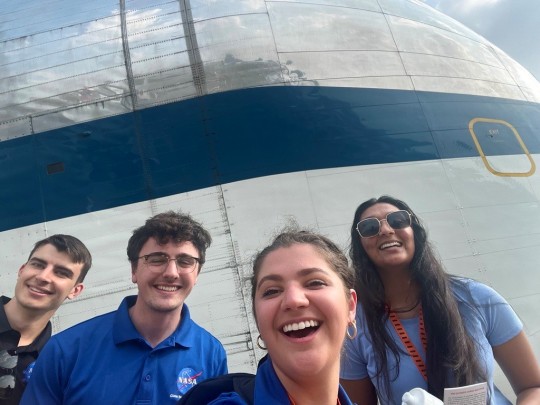
Alex, Evan, Bianca, and Janki pose in front of NASA’s Super Guppy, a specialized aircraft used to transport oversized cargo.
At Oshkosh, one memory in particular stands out for Alex, Bianca, Evan, and Janki: seeing NASA’s famous Super Guppy in person. With a unique hinged nose and a cargo area that's 25 feet in diameter and 111 feet long, the Super Guppy can carry oversized cargo that is impossible to transport with other cargo aircraft.
“We had a very lucky experience… We were able to not only see the Super Guppy, we got to get up close when it landed,” said Bianca, who is receiving her Master's in Business Administration with a specialization in Strategic Communications from Bowling Green State University. “From a learning experience, it gave me a way better basis on cargo aircraft and how they operate.”
For Alex, who is receiving his Master's in Aeronautical Engineering from the Georgia Institute of Technology, it was exciting to see the Super Guppy’s older technology integrated with newer technologies up close. “There have been a lot of good memories, but I think the best one was the Super Guppy. It was cool to see this combination of 60’s and 70’s technology with this upgraded plane.”
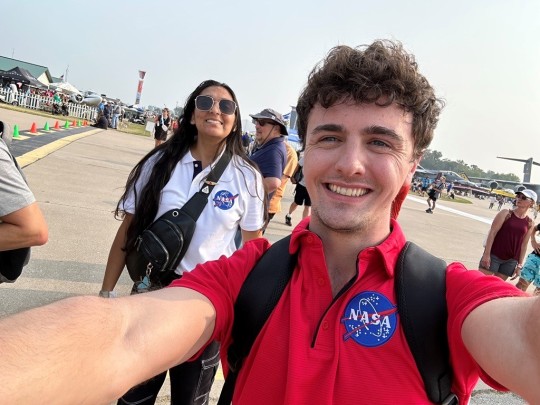
Evan and Janki pose for a photo while walking around EAA AirVenture Oshkosh.
With Oshkosh coming to a close this Sunday, July 30, Alex, Bianca, Evan, and Janki also reflected on advice they have for future NASA interns on how they can get the most out of their internship: be curious and explore, connect with people who work in the field you’re interested in, and don’t be afraid to ask questions.
Alex advises potential NASA interns to “dream big and shoot for your goals, and divide that up into steps… In the end it will work out.” For Bianca, being open and exploring is key: “take opportunities, even if it’s the complete opposite thing that you were intending to do.”
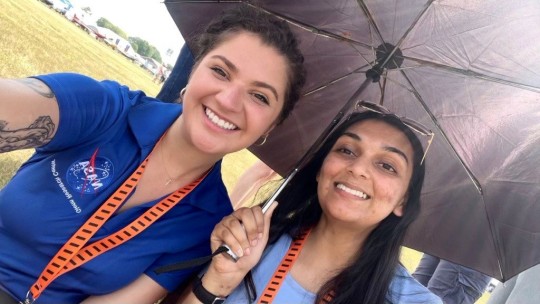
“Ask questions all the time,” said Evan. “Even outside the internship, always continue asking people about what they are knowledgeable on.” And Janki encourages future interns to “Follow your own path. Get the help of mentors, but still do your own thing.”
Visiting Oshkosh and want to see NASA science in action? Stop by the NASA Pavilion, located at Aviation Gateway Park, and see everything from interactive exhibits on sustainable aviation, Advanced Air Mobility, Quesst, and Artemis to STEM activities–and you may even meet NASA pilots, engineers, and astronauts! At Oshkosh, the sky’s the limit.
Interested in interning with NASA? Head over to NASA’s internship website to learn more about internship opportunities with NASA and find your place in (aero)space.
Make sure to follow us on Tumblr for your regular dose of space!
#aeronautics#NASA#aviation#airplane#internships#airventure#intern#work advice#advice#avgeek#aircraft
908 notes
·
View notes
Text
Aviation's huge carbon footprint could shrink significantly with electrification. To date, however, only small all-electric planes have gotten off the ground. Their electric motors generate hundreds of kilowatts of power. To electrify larger, heavier jets, such as commercial airliners, megawatt-scale motors are required. These would be propelled by hybrid or turbo-electric propulsion systems where an electrical machine is coupled with a gas turbine aero-engine.
To meet this need, a team of MIT engineers is now creating a 1-megawatt motor that could be a key stepping stone toward electrifying larger aircraft. The team has designed and tested the major components of the motor, and shown through detailed computations that the coupled components can work as a whole to generate one megawatt of power, at a weight and size competitive with current small aero-engines.
For all-electric applications, the team envisions the motor could be paired with a source of electricity such as a battery or a fuel cell. The motor could then turn the electrical energy into mechanical work to power a plane's propellers. The electrical machine could also be paired with a traditional turbofan jet engine to run as a hybrid propulsion system, providing electric propulsion during certain phases of a flight.
Read more.
14 notes
·
View notes
Text
Innovative Solutions Soar: Unveiling the Dynamics of Mechanical, Aerospace & Defense, and Electrical Engineering Services
In today's fast-paced technological landscape, the convergence of mechanical, aerospace & defense, and electrical engineering services marks a thrilling era of innovation and advancement. From towering skyscrapers to cutting-edge aircraft, and from sophisticated defense systems to intricate electronic devices, the synergy of these disciplines is reshaping the world as we know it.
Unraveling Mechanical Marvels:
Mechanical engineering services form the cornerstone of numerous industries, spanning from automotive to manufacturing. The essence lies in designing, analyzing, and optimizing mechanical systems to enhance efficiency, durability, and performance. With advancements in materials science and computational tools, engineers are pioneering groundbreaking solutions, from lightweight components for fuel-efficient vehicles to precision machinery for industrial automation.
Taking Flight with Aerospace & Defense:
In the realm of aerospace and defense, engineering prowess reaches new heights. From conceptualizing futuristic aircraft to developing state-of-the-art defense systems, the aerospace and defense sector demands unparalleled expertise and innovation. Engineers delve into aerodynamics, propulsion, avionics, and beyond, pushing the boundaries of what's possible. Whether it's enhancing fuel efficiency, bolstering safety measures, or fortifying national security, aerospace and defense engineering services are at the forefront of technological innovation.
Electrifying the Future:
In an increasingly electrified world, electrical engineering services play a pivotal role in powering progress. From renewable energy solutions to smart grids and beyond, electrical engineers are at the forefront of sustainable development. Moreover, the proliferation of electronic devices underscores the importance of robust hardware and software solutions. Be it designing energy-efficient circuits, optimizing power distribution networks, or developing cutting-edge electronic devices, electrical engineering services are indispensable in shaping the future of energy and technology.
The Intersection of Innovation:
What sets the current era apart is the intersection of these disciplines, where mechanical, aerospace & defense, and electrical engineering converge to drive innovation. Take, for instance, the development of electric aircraft, where expertise from all three domains converges to create eco-friendly aviation solutions. Similarly, in defense technology, the integration of mechanical systems, aerospace dynamics, and electrical components leads to the creation of sophisticated defense systems capable of safeguarding nations.
Conclusion:
In the dynamic landscape of engineering services, the fusion of mechanical, aerospace & defense, and electrical engineering heralds a new era of innovation and possibility. From shaping skylines to safeguarding nations and powering progress, these disciplines converge to push the boundaries of what's achievable. As we navigate the complexities of the modern world, the synergy of these engineering services will continue to drive transformative change, propelling us towards a brighter and more sustainable future.
0 notes
Link
4 min read Submit Your 2024 Event Proposal to NASA Glenn Lilia Miller and Molly Kearns, employees from NASA’s Glenn Research Center, discuss communication in space as they build paper satellites with students during a STEM event at Rocket Mortgage Field House in Cleveland, Ohio.NASA/GRC/Jef Janis Solicitation posted: Oct. 26, 2023Proposal form URL: https://osirris.grc.nasa.gov/request/request.cfmProposal submission deadline: Nov. 24, 2023Notification of event selection: Dec. 15, 2023 2024 Call for Event Proposals Opportunity Description NASA’s Glenn Research Center in Cleveland is seeking to collaborate with organizations across the country to bring the NASA experience to new, diverse audiences. This opportunity is designed to provide organizations with: Interactive NASA exhibits and historical artifacts to showcase NASA’s missions and research. Access to NASA subject matter experts for interactive speaking engagements. The center is requesting event proposals to: Reach larger audiences by leveraging the experiences of community organizations with existing high-quality events. Strengthen community relationships by collaborating on efforts that result in increased returns on mutually desired outcomes. Raise awareness of NASA’s contributions to the nation’s aeronautics and space programs. NASA’s Glenn Research Center NASA’s Glenn Research Center in Cleveland designs, develops, and tests innovative technology to revolutionize air travel, advance space exploration, and improve life on Earth. As one of 10 NASA centers, and the only one in the Midwest, Glenn is a vital contributor to the region’s economy and culture. Many NASA missions have Glenn contributions, and every U.S. aircraft has NASA Glenn technology on board, making flight cleaner, safer, and quieter. Glenn is conducting revolutionary aeronautics research in electrified aircraft propulsion, advanced materials, and alternative fuels to help the nation achieve its climate change goals. The center is also exploring next-generation supersonic and hypersonic aircraft. In addition to its aeronautics research, NASA Glenn’s world-class test facilities and unrivaled expertise in power, propulsion, and communications are crucial to advancing the Artemis program. Glenn’s solar electric propulsion will help propel future missions to the Moon and eventually Mars, where astronauts will conduct scientific research and establish a presence on the surface. The road to the Moon goes through Ohio. Glenn’s Expertise: Air-Breathing Propulsion (Jet Engines) Communications In-Space Propulsion and Cryogenic Fluids Management Power, Energy Storage, and Conversion Materials and Structures for Extreme Environments Physical Sciences and Biomedical Technologies in Space Eligibility Requirements NASA is seeking: Organizations with established events that have direct connections to their communities and reach diverse audiences. Greater consideration will be given to organizations reaching underserved and/or underrepresented communities. For purposes of this solicitation, underserved and/or underrepresented communities include Black, Latino, Indigenous, and Native American persons; Asian Americans, Pacific Islanders, and other persons of color; members of religious minorities; lesbian, gay, bisexual, transgender, and queer (LGBTQ+) persons; persons with disabilities; persons who live in rural areas; and persons otherwise adversely affected by persistent poverty or inequality (source: NASA’s Mission Equity). Greater consideration may also be given to organizations throughout the Great Lakes Region (Illinois, Indiana, Michigan, Minnesota, Ohio, and Wisconsin) based on factors such as schedule and budget availability. Events scheduled to occur between Jan. 1, 2024, and Dec. 31, 2024. Selected organizations must agree to the following: Attend mutually agreed-upon planning meetings held virtually through an online business communication platform. Be responsible for coordinating all marketing, media communications, and logistics as described in the event proposal. Adhere to NASA Media Usage Guidelines for NASA media and logos. Provide final attendance data within one week of the conclusion of the event including the following: Number of attendees Estimated percentage of attendees from underrepresented audiences Submitting a Proposal All proposals are to be submitted through the online proposal form here. Proposals must be submitted by 5 p.m. Eastern time on Nov. 24, 2023. Only proposals submitted online will be accepted. Proposal Review Process Proposals will be evaluated to determine the likelihood of event success using the following criteria: Number of proposed audience participants. Percentage of audience from underrepresented populations as defined in the solicitation. Alignment of the program’s goals and objectives to those of this opportunity. Expected return on investment of NASA resources. Plans to maximize audience participation through marketing and media communications. Evidence of historical attendance at this or similar events hosted by the proposing organization. Proposing organizations will be notified of their selection status by Dec. 15, 2022. Point of Contact If you have questions about the project or the online proposal form, contact NASA Glenn Research Center’s Office of Communications at: [email protected] Explore More 1 min read Dr. Guy Bluford Reflects on 40th Anniversary of Historic Shuttle Flight Article 1 week ago 3 min read Glenn in the Community Article 1 week ago 2 min read Glenn “Stars” Showcase Research and Technology Article 1 week ago
0 notes
Text
...
https://questlation.com/prnewswire/5ab6be5839e22a9303a24aa717ae46fd/?feed_id=13367&_unique_id=63db17505b82f
0 notes
Text
[ad_1]
Electric planes might seem futuristic, but they aren’t that far off, at least for short hops.
Two-seater Velis Electros are already quietly buzzing around Europe, electric sea planes are being tested in British Columbia, and larger planes are coming. Air Canada announced on Sept. 15, 2022, that it would buy 30 electric-hybrid regional aircraft from Sweden’s Heart Aerospace, which expects to have its 30-seat plane in service by 2028.
Analysts at the U.S. National Renewable Energy Lab note that the first hybrid electric 50- to 70-seat commuter plane could be ready not long after that. In the 2030s, they say, electric aviation could really take off.
That matters for managing climate change. About 3% of global emissions come from aviation today, and with more passengers and flights expected as the population expands, aviation could be producing three to five times more carbon dioxide emissions by 2050 than it did before the COVID-19 pandemic.
Aerospace engineer and assistant professor Gökçin Çınar develops sustainable aviation concepts, including hybrid-electric planes and hydrogen fuel alternatives, at the University of Michigan. We asked her about the key ways to cut aviation emissions today and where technologies like electrification and hydrogen are headed.
Why is aviation so difficult to electrify?
Aircraft are some of the most complex vehicles out there, but the biggest problem for electrifying them is the battery weight.
If you tried to fully electrify a 737 with today’s batteries, you would have to take out all the passengers and cargo and fill that space with batteries just to fly for under an hour.
Jet fuel can hold about 50 times more energy compared to batteries per unit mass. So, you can have 1 pound of jet fuel or 50 pounds of batteries. To close that gap, we need to either make lithium-ion batteries lighter or develop new batteries that hold more energy. New batteries are being developed, but they aren’t yet ready for aircraft.
Air Canada and United Airlines have ordered 30-seat regional hybrid-electric planes from Heart Aerospace that can go about 125 miles (200 km) fully electric and 250 miles (400 km) as hybrids. With a 25-passenger configuration, the company says the hybrid distance doubles.Heart Aerospace
An electric alternative is hybrids.
Even though we might not be able to fully electrify a 737, we can get some fuel burn benefits from batteries in the larger jets by using hybrid propulsion systems. We are trying to make that happen in the short term, with a 2030-2035 target for smaller regional planes. The less fuel burned during flight, the fewer greenhouse gas emissions.
How does hybrid aviation work to cut emissions?
Hybrid electric aircraft are similar to hybrid electric cars in that they use a combination of batteries and aviation fuels. The problem is that no other industry has the weight limitations that we do in the aerospace industry.
That’s why we have to be very smart about how and how much we are hybridizing the propulsion system.
Using batteries as a power assist during takeoff and climb are very promising options. Taxiing to the runway using just electric power could also save a significant amount of fuel and reduce the local emissions at airports. There is a sweet spot between the added weight of the battery and how much electricity you can use to get net fuel benefits. This optimization problem is at the center of my research.
Hybrids would still burn fuel during flight, but it could be considerably less than just relying entirely on jet fuel.
[embed]https://www.youtube.com/watch?v=71blB6hNV0g[/embed]How hybrid electric aviation could work on large aircraft.
I see hybridization as a mid-term option for larger jets, but a near-term solution for regional aircraft.
For 2030 to 2035, we’re focused on hybrid turboprops, typically regional aircraft with 50-80 passengers or used for freight. These hybrids could cut fuel use by about 10%.
With electric hybrids, airlines could also
make more use of regional airports, reducing congestion and time larger planes spend idling on the runway.
What do you expect to see in the near term from sustainable aviation?
Shorter term we’ll see more use of sustainable aviation fuels, or SAF. With today’s engines, you can dump sustainable aviation fuel into the same fuel tank and burn it. Fuels made from corn, oilseeds, algae and other fats are already being used.
Sustainable aviation fuels can reduce an aircraft’s net carbon dioxide emissions by around 80%, but supply is limited, and using more biomass for fuel could compete with food production and lead to deforestation.
A second option is using synthetic sustainable aviation fuels, which involves capturing carbon from the air or other industrial processes and synthesizing it with hydrogen. But that’s a complex and costly process and does not have a high production scale yet.
Ampaire reported that its hybrid electric EEL had fuel savings up to 40% compared with a standard version of the similar Cessna Skymaster.Ampaire
Airlines can also optimize their operations in the short term, such as route planning to avoid flying nearly empty planes. That can also reduce emissions.
Is hydrogen an option for aviation?
Hydrogen fuel has been around a very long time, and when it’s green hydrogen – produced with water and electrolysis powered by renewable energy – it doesn’t produce carbon dioxide. It can also hold more energy per unit of mass than batteries.
There are two ways to use hydrogen in an airplane: either in place of regular jet fuel in an engine, or combined with oxygen to power hydrogen fuel cells, which then generate electricity to power the aircraft.
The problem is volume – hydrogen gas takes up a lot of space. That’s why engineers are looking at methods like keeping it very cool so it can be stored as liquid until it’s burned as a gas. It still takes up more space than jet fuel, and the storage tanks are heavy, so how to store, handle or distribute it on aircraft is still being worked out.
Airbus is doing a lot of research on hydrogen combustion using modified gas turbine engines with an A380 platform, and aiming to have mature technology by 2025. Australia’s Rex airline expects to start testing a 34-seat, hydrogen-electric airplane for short hops in the next few years.
Due to the variety of options, I see hydrogen as one of the key technologies for sustainable aviation.
Will these technologies be able to meet the aviation industry’s goals for reducing emissions?
The problem with aviation emissions isn’t their current levels – it’s the fear that their emissions will increase rapidly as demand increases. By 2050, we could see three to five times more carbon dioxide emissions from aviation than before the pandemic.
The International Civil Aviation Organization, a United Nations agency, generally defines the industry’s goals, looking at what’s feasible and how aviation can push the boundaries.
Its long-term goal is to cut net carbon dioxide emissions 50% by 2050 compared with 2005 levels. Getting there will require a mix of different technologies and optimization. I don’t know if we’re going to be able to reach it by 2050, but I believe we must do everything we can to make future aviation environmentally sustainable.
Gökçin Çınar, Assistant Professor of Aerospace Engineering, University of Michigan
This article is republished from The Conversation under a Creative Commons license. Read the original article.
[ad_2]
More
0 notes
Text
Aircraft Electrification Market 2022 by Manufacturers, Regions, Type and Application, Forecast to 2030
Aircraft Electrification Market is estimated to be USD 6.0 billion in 2021 and is projected to reach USD 20.0 billion by 2030, at a CAGR of 14.3%.

Aircraft are used to transport goods and passengers all over the world, based on the needs of diverse industries including tourism, logistics, and defence. Due to enormous maintenance and running costs, as well as the enormous purchase expenditures connected with an aeroplane, planes represent a significant portion of an organization's investment. Noise and air pollutants such as carbon dioxide (CO2), nitrogen oxides (NOX), sulphur oxides (SOX), and unburned hydrocarbons (HC) are also released by aircraft, all of which have negative impacts on the environment. To solve the environmental issues given by conventional jet-fuel-based aircraft and to comply with the constraints and requirements set by aviation regulators around the world, aviation businesses are embracing partial or total electrification of aircraft functions. The more electric aircraft technology is developed, the better.
Request a sample copy of Aircraft Electrification Market:- https://wemarketresearch.com/sample-request/aircraft-electrification-market/84/
Increased efforts to reduce reliance on oil are projected to increase demand for aeroplane electrification.
The aircraft industry has slowly and quietly become electrified. Hydraulic and pneumatic systems are gradually giving way to electric-based systems, allowing for the development of more efficient and thus easier-to-maintain aircraft.
Global Aircraft Electrification Market- Segmental Analysis
Based on Component
Batteries
Power Electronics
Electric Pumps
Generators
Fuel Cells
Solar Cells
Electric Actuators
Motors
Distribution Devices
Based on Technology
Fully Electric
More Electric
Hybrid Electric
Based on Application
Power Generation
Energy Store
Power Distribution
Power Conservation
Based on Platform
Fixed Wing
Advanced Air Mobility
Unmanned Aerial Vehicles
Rotary Wing
Based on System
Landing Gear System
Propulsion System
Environmental Control System
Flight Control System
Thrust Reverser System
Purchase Global Aircraft Electrifications Market Research Report:- https://wemarketresearch.com/purchase/aircraft-electrification-market/84/?license=single
Competitive Landscape:
• Honeywell International Inc.
• Safran
• Thales Group
• Raytheon Technologies
• Ampaire
• GE Aviation
• Zunum Aero
• Bye Aerospace
• Nabtesco Corporation
• Hartzell Engine Technologies LLC
• PBS AEROSPACE
• EaglePicher Technologies
• Eviation
• Electroflight
• Radiant Power Corporation
• Meggitt PLC
• Equator Aircraft
• H3X Technologies
• MagniX
• AMETEK Inc.
• Joby Aviation
• Rolls-Royce
• Pipistrel
• BAE System
• Beta Technologies
• Heart Aerospace
• Airbus
• Siemens
• Hartzell Engine Technologies LLC
• PBS AEROSPACE
• EaglePicher Technologies
• Nabtesco Corporation
• Wright Electric
• ZeroAvia
• Others
Key Questions Answered in This Report:
1. How has the global Aircraft Electrification market performed so far and how will it perform in the coming years?
2. What has been the impact of COVID-19 on the global Aircraft Electrification market?
3. What are the key regional markets?
4. What is the breakup of the market based on the type?
5. What is the breakup of the market based on the product?
6. What is the breakup of the market based on the application?
7. What are the various stages in the value chain of the industry?
8. What are the key driving factors and challenges in the industry?
9. What is the structure of the global Aircraft Electrification market and who are the key players?
10. What is the degree of competition in the industry?
About We Market Research
WE MARKET RESEARCH is an established market analytics and research firm with a domain experience sprawling across different industries. We have been working on multi-county market studies right from our inception. Over the time, from our existence, we have gained laurels for our deep rooted market studies and insightful analysis of different markets.
Our strategic market analysis and capability to comprehend deep cultural, conceptual and social aspects of various tangled markets has helped us make a mark for ourselves in the industry. WE MARKET RESEARCH is a frontrunner in helping numerous companies; both regional and international to successfully achieve their business goals based on our in-depth market analysis. Moreover, we are also capable of devising market strategies that ensure guaranteed customer bases for our clients.
Contact Us:
We Market Research
Phone: +1(929)-450-2887
Email: [email protected]
Web: https://wemarketresearch.com/
0 notes
Text
WHEN WOMAN IS BOSS
An interview with Nikola Tesla by John B. Kennedy.
Colliers, January 30, 1926.
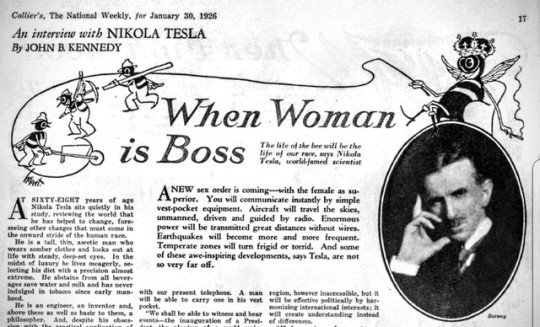
The life of the bee will be the life of our race, says Nikola Tesla, world-famed scientist.
A NEW sex order is coming--with the female as superior. You will communicate instantly by simple vest-pocket equipment. Aircraft will travel the skies, unmanned, driven and guided by radio. Enormous power will be transmitted great distances without wires. Earthquakes will become more and more frequent. Temperate zones will turn frigid or torrid. And some of these awe-inspiring developments, says Tesla, are not so very far off.
AT SIXTY-EIGHT years of age Nikola Tesla sits quietly in his study, reviewing the world that he has helped to change, foreseeing other changes that must come in the onward stride of the human race. He is a tall, thin, ascetic man who wears somber clothes and looks out at life with steady, deep-set eyes. In the midst of luxury he lives meagerly, selecting his diet with a precision almost extreme. He abstains from all beverages save water and milk and has never indulged in tobacco since early manhood.
He is an engineer, an inventor and, above these as well as basic to them, a philosopher. And, despite his obsession with the practical application of what a gifted mind may learn in books, he has never removed his gaze from the drama of life.
This world, amazed many times during the last throbbing century, will rub its eyes and stand breathless before greater wonders than even the past few generations have seen; and fifty years from now the world will differ more from the present-day than our world now differs from the world of fifty years ago.
Nikola Tesla came to America in early manhood, and his inventive genius found quick recognition. When fortune was his through his revolutionary power-transmission machines he established plants, first in New York, then Colorado, later on Long Island, where his innumerable experiments resulted in all manner of important and minor advances in electrical science. Lord Kelvin said of him (before he was forty) that he had contributed more than any other man to the study of electricity.
"From the inception of the wireless system," he says, "I saw that this new art of applied electricity would be of greater benefit to the human race than any other scientific discovery, for it virtually eliminates distance. The majority of the ills from which humanity suffers are due to the immense extent of the terrestrial globe and the inability of individuals and nations to come into close contact.
"Wireless will achieve the closer contact through transmission of intelligence, transport of our bodies and materials and conveyance of energy.
"When wireless is perfectly applied the whole earth will be converted into a huge brain, which in fact it is, all things being particles of a real and rhythmic whole. We shall be able to communicate with one another instantly, irrespective of distance. Not only this, but through television and telephony we shall see and hear one another as perfectly as though we were face to face, despite intervening distances of thousands of miles; and the instruments through which we shall be able to do his will be amazingly simple compared with our present telephone. A man will be able to carry one in his vest pocket.
"We shall be able to witness and hear events--the inauguration of a President, the playing of a world series game, the havoc of an earthquake or the terror of a battle--just as though we were present.
"When the wireless transmission of power is made commercial, transport and transmission will be revolutionized. Already motion pictures have been transmitted by wireless over a short distance. Later the distance will be illimitable, and by later I mean only a few years hence. Pictures are transmitted over wires--they were telegraphed successfully through the point system thirty years ago. When wireless transmission of power becomes general, these methods will be as crude as is the steam locomotive compared with the electric train.
Woman--Free and Regal
ALL railroads will be electrified, and if there are enough museums to hold them the steam locomotives will be grotesque antiques for our immediate posterity.
"Perhaps the most valuable application of wireless energy will be the propulsion of flying machines, which will carry no fuel and will be free from any limitations of the present airplanes and dirigibles. We shall ride from New York to Europe in a few hours. International boundaries will be largely obliterated and a great step will be made toward the unification and harmonious existence of the various races inhabiting the globe. Wireless will not only make possible the supply of energy to region, however inaccessible, but it will be effective politically by harmonizing international interests; it will create understanding instead of differences.
"Modern systems of power transmission will become antiquated. Compact relay stations one half or one quarter the size of our modern power plants will be the basis of operation--in the air and under the sea, for water will effect small loss in conveying energy by wireless."
Mr. Tesla foresees great changes in our daily life. "Present wireless receiving apparatus," says he, "will be scrapped for much simpler machines; static and all forms of interference will be eliminated, so that innumerable transmitters and receivers may be operated without interference. It is more than probable that the household's daily newspaper will be printed 'wirelessly' in the home during the night. Domestic management--the problems of heat, light and household mechanics--will be freed from all labor through beneficent wireless power.
"I foresee the development of the flying machine exceeding that of the automobile, and I expect Mr. Ford to make large contributions toward this progress. The problem of parking automobiles and furnishing separate roads for commercial and pleasure traffic will be solved. Belted parking towers will arise in our large cities, and the roads will be multiplied through sheer necessity, or finally rendered unnecessary when civilization exchanges wheels for wings.
The world's internal reservoirs of heat, indicated by frequent volcanic eruptions, will be tapped for industrial purposes. In an article I wrote twenty years ago I defined a process for continuously converting to human use part of the heat received from the sun by the atmosphere. Experts have jumped to the conclusion that I am attempting to realize a perpetual-motion scheme. But my process has been carefully worked out. It is rational."
Mr. Tesla regards the emergence of woman as one of the most profound portents for the future.
"It is clear to any trained observer," he says, "and even to the sociologically untrained, that a new attitude toward sex discrimination has come over the world through the centuries, receiving an abrupt stimulus just before and after the World War.
"This struggle of the human female toward sex equality will end in a new sex order, with the female as superior. The modern woman, who anticipates in merely superficial phenomena the advancement of her sex, is but a surface symptom of something deeper and more potent fermenting in the bosom of the race.
"It is not in the shallow physical imitation of men that women will assert first their equality and later their superiority, but in the awakening of the intellect of women.
"Through countless generations, from the very beginning, the social subservience of women resulted naturally in the partial atrophy or at least the hereditary suspension of mental qualities which we now know the female sex to be endowed with no less than men.
The Queen is the Center of Life
"BUT the female mind has demonstrated a capacity for all the mental acquirements and achievements of men, and as generations ensue that capacity will be expanded; the average woman will be as well educated as the average man, and then better educated, for the dormant faculties of her brain will be stimulated to an activity that will be all the more intense and powerful because of centuries of repose. Woman will ignore precedent and startle civilization with their progress.
"The acquisition of new fields of endeavor by women, their gradual usurpation of leadership, will dull and finally dissipate feminine sensibilities, will choke the maternal instinct, so that marriage and motherhood may become abhorrent and human civilization draw closer and closer to the perfect civilization of the bee."
The significance of this lies in the principle dominating the economy of the bee--the most highly organized and intelligently coordinated system of any form of nonrational animal life--the all-governing supremacy of the instinct for immortality which makes divinity out of motherhood.
The center of all bee life is the queen. She dominates the hive, not through hereditary right, for any egg may be hatched into a reigning queen, but because she is the womb of this insect race.
We Can Only Sit and Wonder
THERE are the vast, desexualized armies of workers whose sole aim and happiness in life is hard work. It is the perfection of communism, of socialized, cooperative life wherein all things, including the young, are the property and concern of all.
Then there are the virgin bees, the princess bees, the females which are selected from the eggs of the queen when they are hatched and preserved in case an unfruitful queen should bring disappointment to the hive. And there are the male bees, few in number, unclean of habit, tolerated only because they are necessary to mate with the queen.
When the time is ripe for the queen to take her nuptial flight the male bees are drilled and regimented. The queen passes the drones which guard the gate of the hive, and the male bees follow her in rustling array. Strongest of all the inhabitants of the hive, more powerful than any of her subjects, the queen launches into the air, spiraling upward and upward, the male bees following. Some of the pursuers weaken and fail, drop out of the nuptial chase, but the queen wings higher and higher until a point is reached in the far ether where but one of the male bees remains. By the inflexible law of natural selection he is the strongest, and he mates with the queen. At the moment of marriage his body splits asunder and he perishes.
The queen returns to the hive, impregnated, carrying with her tens of thousands of eggs--a future city of bees, and then begins the cycle of reproduction, the concentration of the teeming life of the hive in unceasing work for the birth of a new generation.
Imagination falters at the prospect of human analogy to this mysterious and superbly dedicated civilization of the bee; but when we consider how the human instinct for race perpetuation dominates life in its normal and exaggerated and perverse manifestations, there is ironic justice in the possibility that this instinct, with the continuing intellectual advance of women, may be finally expressed after the manner of the bee, though it will take centuries to break down the habits and customs of peoples that bar the way to such a simiply and scientifically ordered civilization.
We have seen a beginning of this in the United States. In Wisconsin the sterilization of confirmed criminals and pre-marriage examination of males is required by law, while the doctrine of eugenics is now boldly preached where a few decades ago its advocacy was a statutory offense.
Old men have dreamed dreams and young men have seen visions from the beginning of time. We of today can only sit and wonder when a scientist has his say.
#nikola tesla#interview#quotes#prediction#future#technology#climate change#smartphone#transportation#energy#wireless#ahead of his time#ahead of our time#science#history
1K notes
·
View notes
Text
NASA Issues Contracts to Mature Electrified Aircraft Propulsion Technologies
NASA has selected two U.S. companies to support its Electric Powertrain Flight Demonstration (EPFD) that will rapidly mature Electrified Aircraft Propulsion (EAP) technologies through ground and flight demonstrations.
from NASA https://ift.tt/2WqlA82
0 notes
Text
A Beginner’s Guide to Sustainable Aviation
Do you dream of catching a short flight between cities or journeying across the globe? The aviation industry currently makes up 2-3% of all carbon emissions, but the shift toward electric and hybrid aircraft will help tackle climate change and minimize the environmental impacts of commercial aviation.
Sustainable flight will revolutionize the way we travel. From battery-powered aircraft that reduce fuel consumption, to new lightweight materials that can improve safety and efficiency during flight, here are a few important things to know about the world of sustainable aviation, and what it takes to make air travel cleaner and safer for our planet.
What is Electrified Aircraft Propulsion?
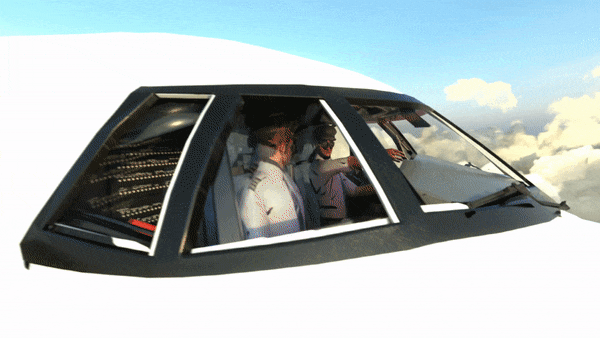
Similar to electric or hybrid-electric cars, sustainable aircraft designs feature electric powertrain systems – the system of components that help propel an aircraft during flight – to help reduce fuel use and emissions. Electrified Aircraft Propulsion (EAP) systems let aircraft work using electric motors, and alternative fuels, rather than relying solely on traditional jet engines burning fossil fuels. At NASA, we’re developing innovative EAP technologies ranging from advanced electric machines designed to increase power and performance to new aircraft materials developed to minimize weight and reduce fuel usage.
What are the challenges with electrifying flight?


Unlike electric vehicles on the ground, electrified aircraft face greater challenges when managing weight and heat while they’re running. In order to ensure maximum efficiency and safety, aircraft components must be designed with minimal weight to help reduce the amount of drag slowing the plane down and causing excess fuel burn. Electrified aircraft must also have advanced thermal management systems to help transfer heat effectively, and ensure onboard systems are kept cool to avoid damage.
Our research and development of EAP technologies offer innovative solutions to these challenges. Designed to keep weight at a minimum, aircraft components such as the High Efficiency Megawatt Motor feature advanced technology that enable increased power and efficiency with three times less heat loss and weight than traditional aircraft motors. New material technologies such as electrical insulation also help transport heat more effectively to minimize heat buildup and are made of lightweight materials to ensure efficiency at high altitudes.
What are the benefits of sustainable aviation?

From an environmental perspective, aircraft electrification offers unique opportunities to lower global emissions and minimize reliance on fossil fuels. The introduction of hybrid- or fully electric aircraft will significantly reduce overall fuel consumption by generating power and thrust via electricity and electric motors. Lightweight EAP systems and components can also help improve aircraft efficiency and reduce fuel burn, while using non-conventional, alternative fuels can help reduce harmful emissions. From an economic standpoint, EAP technologies could help strengthen commercial airliner markets with aircraft designed for around 180 passengers. Green technologies can also benefit both airline companies and you when you fly by potentially reducing aircraft maintenance and in-flight energy costs, making air travel more affordable.
When will sustainable flight take off?
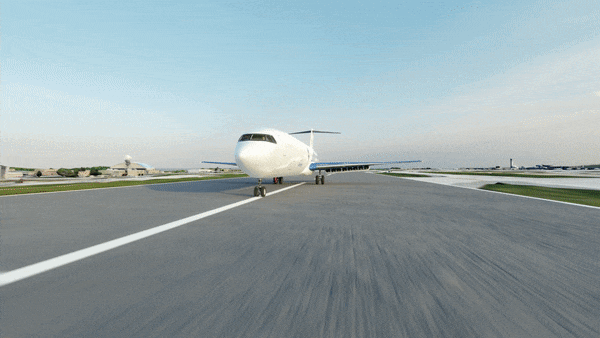
To help turn visions of eco-friendly air travel into reality, we’re teaming up with industry to test EAP technologies on aircraft and introduce them to the U.S. commercial aviation fleet no later than 2035.
Under our Electrified Powertrain Flight Demonstration (EPFD) project, we will conduct ground and flight tests using existing aircraft modified with EAP systems to assist in transitioning these technologies into commercial products. Flight demonstrations will also enable us to identify key risks and barriers associated with integrating new EAP systems into commercial airliners and develop new standards for future EAP aircraft as they take to the skies within the next decade.
There you have it: a quick glimpse into the world of sustainable aviation, and the shift towards keeping our skies cleaner and safer. As we embark on this journey, climb aboard and stay up to date on our latest technology developments and future flight demonstrations.
Make sure to follow us on Tumblr for your regular dose of space!
#NASA Aeronautics#Sustainable Aviation#Sustainability#Climate Change#Electrified Aircraft Propulsion#Electrified Powertrain Flight Demonstration#Aviation#Flight#Technology#Earth Day#travel#travelblr#sustainable#aircraft#NASA
2K notes
·
View notes
Text
NASA, U.S. Industry Aim to Electrify Commercial Aviation
NASA, U.S. Industry Aim to Electrify Commercial Aviation
Hello everyone! Putting a little science here on Science + Sigils. Electric planes!!
NASA is exploring electrified aircraft propulsion as an alternative to jet-engine powered flight.
Source: NASA, U.S. Industry Aim to Electrify Commercial Aviation
View On WordPress
2 notes
·
View notes
Text
The World Ahead 2022
What next? 22 Emerging Technologies To Watch In 2022! New Ideas Can Emerge Seemingly Overnight
— November 8th, 2021 | By The Science and Technology Correspondents of The Economist

The astonishingly rapid development and rollout of coronavirus vaccines has been a reminder of the power of science and technology to change the world. Although vaccines based on new mrna technology seemed to have been created almost instantly, they actually drew upon decades of research going back to the 1970s. As the saying goes in the technology industry, it takes years to create an overnight success. So what else might be about to burst into prominence? Here are 22 emerging technologies worth watching in 2022
Solar Geoengineering
It sounds childishly simple. If the world is getting too hot, why not offer it some shade? The dust and ash released into the upper atmosphere by volcanoes is known to have a cooling effect: Mount Pinatubo’s eruption in 1991 cooled the Earth by as much as 0.5°C for four years. Solar geoengineering, also known as solar radiation management, would do the same thing deliberately.
This is hugely controversial. Would it work? How would rainfall and weather patterns be affected? And wouldn’t it undermine efforts to curb greenhouse-gas emissions? Efforts to test the idea face fierce opposition from politicians and activists. In 2022, however, a group at Harvard University hopes to conduct a much-delayed experiment called scopex. It involves launching a balloon into the stratosphere, with the aim of releasing 2kg of material (probably calcium carbonate), and then measuring how it dissipates, reacts and scatters solar energy.
Proponents argue that it is important to understand the technique, in case it is needed to buy the world more time to cut emissions. The Harvard group has established an independent advisory panel to consider the moral and political ramifications. Whether the test goes ahead or not, expect controversy.
Heat Pumps
Keeping buildings warm in winter accounts for about a quarter of global energy consumption. Most heating relies on burning coal, gas or oil. If the world is to meet its climate-change targets, that will have to change. The most promising alternative is to use heat pumps—essentially, refrigerators that run in reverse.
Instead of pumping heat out of a space to cool it down, a heat pump forces heat in from the outside, warming it up. Because they merely move existing heat around, they can be highly efficient: for every kilowatt of electricity consumed, heat pumps can deliver 3kw of heat, making them cheaper to run than electric radiators. And running a heat pump backwards cools a home rather than heating it.
Gradient, based in San Francisco, is one of several companies offering a heat pump that can provide both heating and cooling. Its low-profile, saddle-bag shaped products can be mounted in windows, like existing air conditioners, and will go on sale in 2022.

Hydrogen-powered Planes
Electrifying road transport is one thing. Aircraft are another matter. Batteries can only power small aircraft for short flights. But might electricity from hydrogen fuel cells, which excrete only water, do the trick? Passenger planes due to be test-flown with hydrogen fuel cells in 2022 include a two-seater being built at Delft University of Technology in the Netherlands. ZeroAvia, based in California, plans to complete trials of a 20-seat aircraft, and aims to have its hydrogen-propulsion system ready for certification by the end of the year. Universal Hydrogen, also of California, hopes its 40-seat plane will take off in September 2022.

Direct Air Capture
Carbon dioxide in the atmosphere causes global warming. So why not suck it out using machines? Several startups are pursuing direct air capture (dac), a technology that does just that. In 2022 Carbon Engineering, a Canadian firm, will start building the world’s biggest dac facility in Texas, capable of capturing 1m tonnes of CO2 per year. ClimeWorks, a Swiss firm, opened a dac plant in Iceland in 2021, which buries captured CO2 in mineral form at a rate of 4,000 tonnes a year. Global Thermostat, an American firm, has two pilot plants. dac could be vital in the fight against climate change. The race is on to get costs down and scale the technology up.
Vertical Farming
A new type of agriculture is growing. Vertical farms grow plants on trays stacked in a closed, controlled environment. Efficient led lighting has made the process cheaper, though energy costs remain a burden. Vertical farms can be located close to customers, reducing transport costs and emissions. Water use is minimised and bugs are kept out, so no pesticides are needed.
In Britain, the Jones Food Company will open the world’s largest vertical farm, covering 13,750 square metres, in 2022. AeroFarms, an American firm, will open its largest vertical farm, in Daneville, Virginia. Other firms will be expanding, too. Nordic Harvest will enlarge its facility just outside Copenhagen and construct a new one in Stockholm. Plenty, based in California, will open a new indoor farm near Los Angeles. Vertical farms mostly grow high-value leafy greens and herbs, but some are venturing into tomatoes, peppers and berries. The challenge now is to make the economics stack up, too.
Container Ships With Sails
Ships produce 3% of greenhouse-gas emissions. Burning maritime bunker fuel, a dirty diesel sludge, also contributes to acid rain. None of this was a problem in the age of sail—which is why sails are making a comeback, in high-tech form, to cut costs and emissions.
In 2022 Michelin of France will equip a freighter with an inflatable sail that is expected to reduce fuel consumption by 20%. mol, a Japanese shipping firm, plans to put a telescoping rigid sail on a ship in August 2022. Naos Design of Italy expects to equip eight ships with its pivoting and foldable hard “wing sails”. Other approaches include kites, “suction wings” that house fans, and giant, spinning cylinders called Flettner rotors. By the end of 2022 the number of big cargo ships with sails of some kind will have quadrupled to 40, according to the International Windship Association. If the European Union brings shipping into its carbon-trading scheme in 2022, as planned, that will give these unusual technologies a further push.

VR Workouts
Most people do not do enough exercise. Many would like to, but lack motivation. Virtual reality (vr) headsets let people play games and burn calories in the process, as they punch or slice oncoming shapes, or squat and shimmy to dodge obstacles. vr workouts became more popular during the pandemic as lockdowns closed gyms and a powerful, low-cost headset, the Oculus Quest 2, was released. An improved model and new fitness features are coming in 2022. And Supernatural, a highly regarded vr workout app available only in North America, may be released in Europe. Could the killer app for virtual reality be physical fitness?

Vaccines For HIV and Malaria
The impressive success of coronavirus vaccines based on messenger rna (mrna) heralds a golden era of vaccine development. Moderna is developing an hiv vaccine based on the same mrna technology used in its highly effective coronavirus vaccine. It entered early-stage clinical trials in 2021 and preliminary results are expected in 2022. BioNTech, joint-developer of the Pfizer-BioNTech coronavirus vaccine, is working on an mrna vaccine for malaria, with clinical trials expected to start in 2022. Non-mrna vaccines for hiv and malaria, developed at the University of Oxford, are also showing promise.
3D-Printed Bone Implants
For years, researchers have been developing techniques to create artificial organs using 3d printing of biological materials. The ultimate goal is to take a few cells from a patient and create fully functional organs for transplantation, thus doing away with long waiting-lists, testing for matches and the risk of rejection.
That goal is still some way off for fleshy organs. But bones are less tricky. Two startups, Particle3d and adam, hope to have 3d-printed bones available for human implantation in 2022. Both firms use calcium-based minerals to print their bones, which are made to measure based on patients’ ct scans. Particle3d’s trials in pigs and mice found that bone marrow and blood vessels grew into its implants within eight weeks. adam says its 3d-printed implants stimulate natural bone growth and gradually biodegrade, eventually being replaced by the patient’s bone tissue. If all goes well, researchers say 3d-printed blood vessels and heart valves are next.
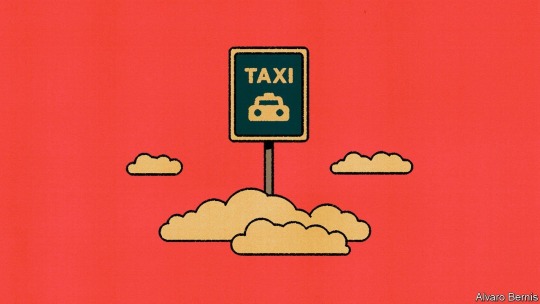
Flying Electric Taxis
Long seen as something of a fantasy, flying taxis, or electric vertical take-off and landing (evtol) aircraft, as the fledgling industry calls them, are getting serious. Several firms around the world will step up test flights in 2022 with the aim of getting their aircraft certified for commercial use in the following year or two. Joby Aviation, based in California, plans to build more than a dozen of its five-seater vehicles, which have a 150-mile range. Volocopter of Germany aims to provide an air-taxi service at the 2024 Paris Olympics. Other contenders include eHang, Lilium and Vertical Aerospace. Keep an eye on the skies.
Space Tourism
After a stand-out year for space tourism in 2021, as a succession of billionaire-backed efforts shot civilians into the skies, hopes are high for 2022. Sir Richard Branson’s Virgin Galactic just beat Jeff Bezos’s Blue Origin to the edge of space in July, with both billionaires riding in their own spacecraft on suborbital trips. In September Elon Musk’s company, SpaceX, sent four passengers on a multi-day orbital cruise around the Earth.
All three firms hope to fly more tourists in 2022, which promises to be the first year in which more people go to space as paying passengers than as government employees. But Virgin Galactic is modifying its vehicle to make it stronger and safer, and it is not expected to fly again until the second half of 2022, with commercial service starting in the fourth quarter. Blue Origin plans more flights but has not said when or how many. For its part, SpaceX has done a deal to send tourists to the International Space Station. Next up? The Moon.

Delivery Drones
They are taking longer than expected to get off the ground. But new rules, which came into effect in 2021, will help drone deliveries gain altitude in 2022. Manna, an Irish startup which has been delivering books, meals and medicine in County Galway, plans to expand its service in Ireland and into Britain. Wing, a sister company of Google, has been doing test deliveries in America, Australia and Finland and will expand its mall-to-home delivery service, launched in late 2021. Dronamics, a Bulgarian startup, will start using winged drones to shuttle cargo between 39 European airports. The question is: will the pace of drone deliveries pick up—or drop off?
Quieter Supersonic Aircraft
For half a century, scientists have wondered whether changes to the shape of a supersonic aircraft could reduce the intensity of its sonic boom. Only recently have computers become powerful enough to run the simulations needed to turn those noise-reduction theories into practice.
In 2022 nasa’s x-59 Quesst (short for “Quiet Supersonic Technology”) will make its first test flight. Crucially, that test will take place over land—specifically, Edwards Air Force Base in California. Concorde, the world’s first and only commercial supersonic airliner, was not allowed to travel faster than sound when flying over land. The x-59’s sonic boom is expected to be just one-eighth as loud as Concorde’s. At 75 perceived decibels, it will be equivalent to a distant thunderstorm—more of a sonic “thump”. If it works, nasa hopes that regulators could lift the ban on supersonic flights over land, ushering in a new era for commercial flight.

3D-Printed Houses
Architects often use 3d printing to create scale models of buildings. But the technology can be scaled up and used to build the real thing. Materials are squirted out of a nozzle as a foam that then hardens. Layer by layer, a house is printed—either on site, or as several pieces in a factory that are transported and assembled.
In 2022 Mighty Buildings, based in California, will complete a development of 15 eco-friendly 3d-printed homes at Rancho Mirage. And icon, based in Texas, plans to start building a community of 100 3d-printed homes near Austin, which would be the largest development of its kind.

Sleep Tech
It’s become a craze in Silicon Valley. Not content with maximising their productivity and performance during their waking hours, geeks are now optimising their sleep, too, using an array of technologies. These include rings and headbands that record and track sleep quality, soothing sound machines, devices to heat and cool mattresses, and smart alarm clocks to wake you at the perfect moment. Google launched a sleep-tracking nightstand tablet in 2021, and Amazon is expected to follow suit in 2022. It sounds crazy. But poor sleep is linked with maladies from heart disease to obesity. And what Silicon Valley does today, everyone else often ends up doing tomorrow.
Personalised Nutrition
Diets don't work. Evidence is growing that each person’s metabolism is unique, and food choices should be, too. Enter personalised nutrition: apps that tell you what to eat and when, using machine-learning algorithms, tests of your blood and gut microbiome, data on lifestyle factors such as exercise, and real-time tracking of blood-sugar levels using coin-sized devices attached to the skin. After successful launches in America, personalised-nutrition firms are eyeing other markets in 2022. Some will also seek regulatory approval as treatments for conditions such as diabetes and migraine.
Wearable Health Trackers
Remote medical consultations have become commonplace. That could transform the prospects for wearable health trackers such as the Fitbit or Apple Watch. They are currently used primarily as fitness trackers, measuring steps taken, running and swimming speeds, heart rates during workouts, and so forth. But the line between consumer and medical uses of such devices is now blurring, say analysts at Gartner, a consultancy.
Smart watches can already measure blood oxygenation, perform ecgs and detect atrial fibrillation. The next version of the Apple Watch, expected in 2022, may include new sensors capable of measuring levels of glucose and alcohol in the blood, along with blood pressure and body temperature. Rockley Photonics, the company supplying the sensor technology, calls its system a “clinic on the wrist”. Regulatory approval for such functions may take a while, but in the meantime doctors, not just users, will be paying more attention to data from wearables.
The Metaverse
Coined in 1992 by Neal Stephenson in his novel “Snow Crash”, the word “metaverse” referred to a persistent virtual world, accessible via special goggles, where people could meet, flirt, play games, buy and sell things, and much more besides. In 2022 it refers to the fusion of video games, social networking and entertainment to create new, immersive experiences, like swimming inside your favourite song at an online concert. Games such as Minecraft, Roblox and Fortnite are all stepping-stones to an emerging new medium. Facebook has renamed itself Meta to capitalise on the opportunity—and distract from its other woes.
Quantum Computing
An idea that existed only on blackboards in the 1990s has grown into a multi-billion dollar contest between governments, tech giants and startups: harnessing the counter-intuitive properties of quantum physics to build a new kind of computer. For some kinds of mathematics a quantum computer could outperform any non-quantum machine that could ever be built, making quick work of calculations used in cryptography, chemistry and finance.
But when will such machines arrive? One measure of a quantum computer’s capability is its number of qubits. A Chinese team has built a computer with 66 qubits. ibm, an American firm, hopes to hit 433 qubits in 2022 and 1,000 by 2023. But existing machines have a fatal flaw: the delicate quantum states on which they depend last for just a fraction of a second. Fixing that will take years. But if existing machines can be made useful in the meantime, quantum computing could become a commercial reality much sooner than expected.

Virtual Influencers
Unlike a human influencer, a virtual influencer will never be late to a photoshoot, get drunk at a party or get old. That is because virtual influencers are computer-generated characters who plug products on Instagram, Facebook and TikTok.
The best known is Miquela Sousa, or “Lil Miquela”, a fictitious Brazilian-American 19-year-old with 3m Instagram followers. With $15bn expected to be spent on influencer marketing in 2022, virtual influencers are proliferating. Aya Stellar—an interstellar traveller crafted by Cosmiq Universe, a marketing agency—will land on Earth in February. She has already released a song on YouTube.
Brain Interfaces
In April 2021 the irrepressible entrepreneur Elon Musk excitedly tweeted that a macaque monkey was “literally playing a video game telepathically using a brain chip”. His company, Neuralink, had implanted two tiny sets of electrodes into the monkey’s brain. Signals from these electrodes, transmitted wirelessly and then decoded by a nearby computer, enabled the monkey to move the on-screen paddle in a game of Pong using thought alone.
In 2022 Neuralink hopes to test its device in humans, to enable people who are paralysed to operate a computer. Another firm, Synchron, has already received approval from American regulators to begin human trials of a similar device. Its “minimally invasive” neural prosthetic is inserted into the brain via blood vessels in the neck. As well as helping paralysed people, Synchron is also looking at other uses, such as diagnosing and treating nervous-system conditions including epilepsy, depression and hypertension.
Artificial Meat and Fish
Winston Churchill once mused about “the absurdity of growing a whole chicken to eat the breast or wing”. Nearly a century later, around 70 companies are “cultivating” meats in bioreactors. Cells taken from animals, without harming them, are nourished in soups rich in proteins, sugars, fats, vitamins and minerals. In 2020 Eat Just, an artificial-meat startup based in San Francisco, became the first company certified to sell its products, in Singapore.
It is expected to be joined by a handful of other firms in 2022. In the coming year an Israeli startup, SuperMeat, expects to win approval for commercial sales of cultivated chicken burgers, grown for $10 a pop—down from $2,500 in 2018, the company says. Finless Foods, based in California, hopes for approval to sell cultivated bluefin tuna, grown for $440 a kilogram—down from $660,000 in 2017. Bacon, turkey and other cultivated meats are in the pipeline. Eco-conscious meat-lovers will soon be able to have their steak—and eat it.
— By the Science and technology correspondents of The Economist■
— This article appeared in the What next? section of the print edition of The World Ahead 2022 under the headline “What next?”
0 notes
Text
NASA Issues Contracts to Mature Electrified Aircraft Propulsion Technologies
NASA Issues Contracts to Mature Electrified Aircraft Propulsion Technologies
NASA has selected two U.S. companies to support its Electric Powertrain Flight Demonstration (EPFD) that will rapidly mature Electrified Aircraft Propulsion (EAP) technologies through ground and flight demonstrations.
Through the EPFD program, NASA seeks to introduce EAP technologies to U.S. aviation fleets no later than 2035, supporting short-range and regional commercial air travel, as well as…

View On WordPress
0 notes